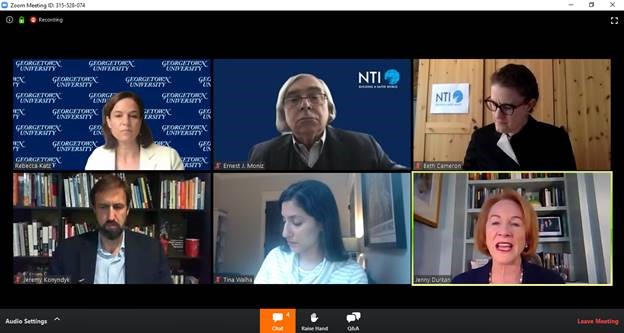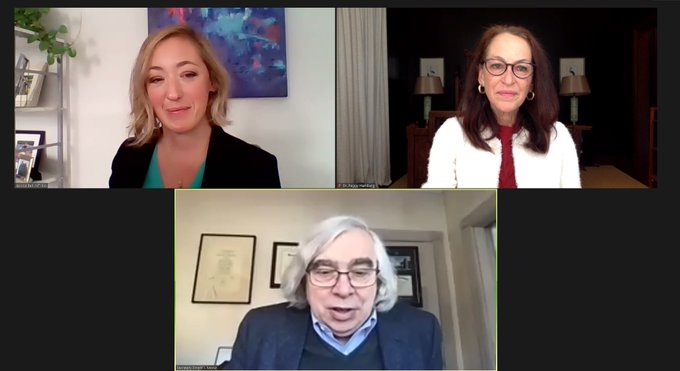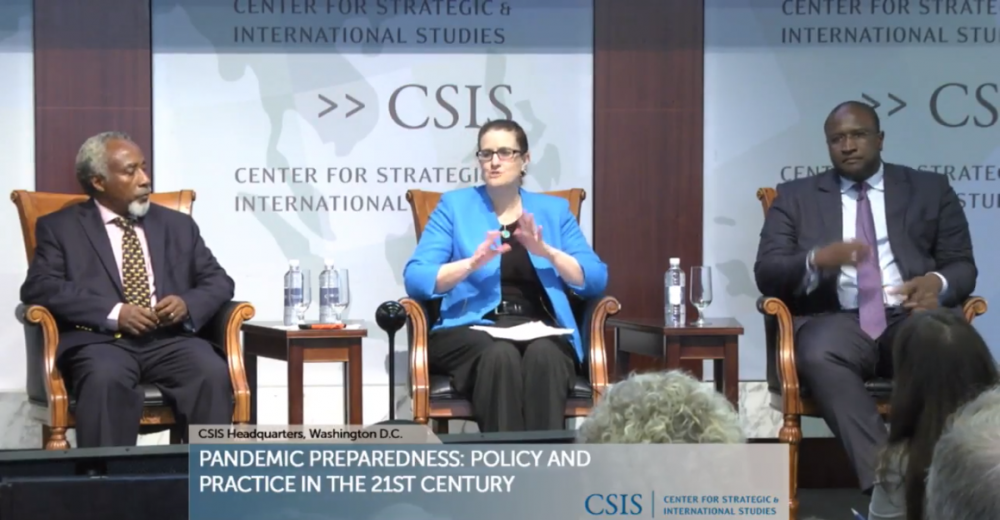
Chris Isaac
Program Officer, Global Biological Policy and Programs
Atomic Pulse
As heads of state work to address the spread of the COVID-19
global pandemic, mayors and other community leaders bear the burden of coordinating
the battle against the deadly virus at the local level and steeling their cities
and towns against a disease with no cure. With limited guidance from federal
authorities and even more limited resources, civic leaders need support in the
critical fight to flatten the curve.
The Nuclear Threat Initiative (NTI) recently hosted a
webinar to discuss the new COVID-19 Frontline
Guide for Local Decision-Makers, a joint project of NTI I bio,
Georgetown University’s Center for Global Health Science and Security, and the
Center for Global Development designed to help local leaders with easy access
to checklists, decision points, and progress indicators as they begin, assess,
and sustain their response to COVID-19.
NTI Co-chairs Ernest J. Moniz and Sam Nunn and NTI Vice
President Dr. Beth Cameron were joined on the webinar by Seattle Mayor Jenny
Durkan, who has been on the front lines of the COVID-19 battle in hard-hit
Washington state. The discussion focused on the role of city authorities, highlighting
many of the lessons Seattle officials learned in recent weeks. Durkan
emphasized that “the response (to COVID-19) is a dial that you cannot turn
quickly enough.” She stressed the need for communities to move rapidly and
cooperate to slow transmission though social distancing measures. Her message
to other leaders was loud and clear: “Act. Act now. Act boldly.”
Moniz noted that many communities don’t have what they need
to address the crisis. “Many local leaders making life and death decisions about
this pandemic don’t have the full resources of (cities like) Seattle,” he said.
“They don’t have the budget to address a crisis of this magnitude, and their
health departments often consist of only one or two people. In a crisis,
they’re understaffed, under-resourced, and lack the tools needed to make
decisions in this crises environment.”
Following their remarks, Cameron moderated a panel
discussion with:
The panel discussion and subsequent Q&A touched on the impact
of COVID-19 on state and local communities around the United States, as well as
implications for international audiences. Overall, the discussion could be
encapsulated by four themes: the importance of cooperation, low-resource areas,
vulnerable populations, and future phases of the response.
The Importance of Cooperation
While small towns have fewer resources than larger cities,
they also have certain advantages. First, a small population can be more
effectively organized to close down gatherings and adopt physical distancing.
Second, it is easier to integrate response with frontline medical personnel to
obtain timely and accurate information about community transmission. Communities
also can mitigate the effects of personal protective equipment (PPE) shortages by
cancelling elective medical procedures, following scientific guidance to extend
the life of PPE, and sourcing additional PPE from local dentists, veterinarians,
and labs. Additionally, communities can coordinate with non-governmental and
private-sector partners who can bring their own passion, data, and skills to
the response.
Low-Resource Areas
One of the big lessons learned is that local action makes a
big difference in all resource environments during outbreaks, as we saw during
the 2014 Ebola outbreak in West Africa and as was reported following the 1918
influenza pandemic. In Africa, low-resource areas had some advantages:
extensive lab infrastructure due to previous investments in HIV testing
capacity and large numbers of health care workers. In the future, a version of
the COVID-Local Guide tailored for low-resource communities will be available.
Vulnerable Populations
The needs and safety of vulnerable populations also must be
considered in depth during the response. Assisted-living homes and similar
facilities should be protected swiftly and mitigation efforts put in place the
moment a presumptive case is identified. Displaced people and refugees are also
often in high-density living arrangements, increasing the risks of transmission
in those communities. The decision to close schools is a difficult one that
resonates through a community because schools provide more than just education.
They often serve as a child-care facility, a source of food and nutrition, and a
social support system while parents are engaged in other essential activities.
Future Phases
Testing is key to re-opening society. Polymerase Chain
Reaction (PCR) tests can indicate who has COVID-19, and serological antibody
tests can determine who has had it and since recovered. Based on the medical
community’s understanding of other coronaviruses, doctors expect recovered
individuals to have some amount of immunity but they don’t know how long any
immunity would last.
In the coming weeks, experts will continue to refine the
COVID Frontline Guide tool. Next steps include:
If you have additional feedback or comments, please visit www.COVID-local.org and use
the Contact Us option. Please also feel free to share the guide with partners
in the United States and elsewhere.
The full webinar can be viewed below:
Sign up for our newsletter to get the latest on nuclear and biological threats.
Examples from around the world of the Global Health Security Index in-use.
NTI Seminar: Dr. Margaret Hamburg on COVID-19 Vaccines, Therapeutics, and the Biosecurity Nexus
Experts at CSIS Symposium Discuss Ebola Response and Putting Global Health Security Policy into Practice



